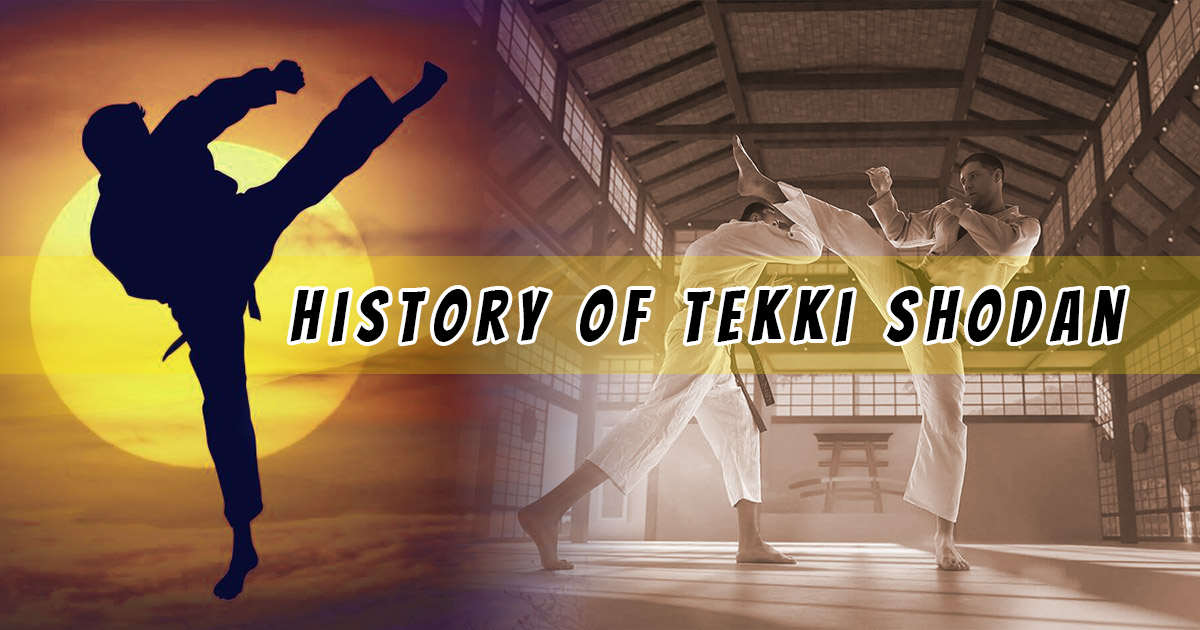Tekki Shodan is one of the most fundamental katas in Shotokan karate, known for its strong stances and focus on lateral movements. It is the first kata in the Tekki series, and its roots run deep in the history of karate. Here are five fascinating facts about the history of Tekki Shodan:
- Tekki Shodan was originally called Naihanchi. The name “Tekki” means “iron horse,” referring to the strong stances used in the kata.
- It was adapted for modern karate by Gichin Funakoshi, the founder of Shotokan karate, who believed in its importance for building foundational skills.
- Tekki Shodan emphasizes lateral movements, which help practitioners improve their balance and stability.
- The kata was designed for self-defense in confined spaces, which is why it features a narrow, immovable stance.
- Mastery of Tekki Shodan is essential for progressing in karate, as it teaches important principles of body control and hip rotation.
What is Tekki Shodan? An Overview of this Iconic Kata
Tekki Shodan is one of the foundational katas in Shotokan karate, specifically known for its significance in the History of Tekki Shodan. The word “kata” refers to a series of predefined movements that simulate a fight against imaginary opponents. Tekki Shodan is the first of three katas in the Tekki series, known for its unique emphasis on side-to-side movements and powerful stances.
This kata helps students develop strength, stability, and balance, particularly through the use of the “kiba dachi” (horse stance), which requires practitioners to maintain a low, grounded position. Because of its technical complexity, Tekki Shodan is typically taught to students after they have mastered basic katas like Heian Shodan and Heian Nidan.
Origins of Tekki Shodan: From Naihanchi to Modern-Day Karate
The history of Tekki Shodan dates back to the Naihanchi kata, which was practiced in Okinawa, Japan. Naihanchi was a defensive kata used to teach fighters how to defend themselves in narrow spaces like hallways or between two opponents.
When Gichin Funakoshi introduced karate to mainland Japan, he renamed the kata to Tekki Shodan and incorporated it into his Shotokan karate system. While the core movements and principles of Naihanchi remained the same, Funakoshi made slight modifications to fit the evolving needs of modern karate training.
The Role of Gichin Funakoshi in the Evolution of Tekki Shodan
Gichin Funakoshi, known as the father of Shotokan karate, played a significant role in the evolution of Tekki Shodan. Funakoshi admired the kata’s emphasis on strong, rooted stances and believed it was an excellent training tool for developing hip rotation, power, and body control.
In his teachings, Funakoshi stressed the importance of Tekki Shodan for both beginners and advanced students, noting that mastering this kata was essential for learning more advanced techniques in karate. Today, Tekki Shodan remains a staple in the Shotokan curriculum, representing the blend of Okinawan tradition and modern martial arts practice.
Tekki Shodan in Shotokan Karate: Key Movements and Techniques
The key movements of Tekki Shodan are designed to build strength, stability, and precision. One of the most defining features of Tekki Shodan is its lateral movements, which require students to step side-to-side rather than forward or backward, as seen in many other katas.
- Kiba Dachi (Horse Stance): Tekki Shodan heavily relies on the kiba dachi stance, which is a wide, low stance that strengthens the legs and core.
- Gedan Barai (Downward Block): This block is used to deflect attacks aimed at the lower body.
- Uraken Uchi (Back Fist Strike): A quick, powerful strike delivered with the back of the fist, typically aimed at the opponent’s face or neck.
- Oi Zuki (Lunge Punch): A forward punch used in many karate katas, designed to maximize speed and power through hip rotation.
These techniques, while simple in appearance, require precision and control, which is why Tekki Shodan is so valuable for karate students.
Why Tekki Shodan is Essential for Karate Practitioners
Tekki Shodan holds a special place in Shotokan karate due to its focus on rooted stances and body mechanics. Practicing this kata helps karateka (karate practitioners) improve their lower body strength, balance, and control over their movements. These skills are critical not only for self-defense but also for mastering more advanced karate techniques.
By focusing on lateral movements and controlled stances, Tekki Shodan teaches practitioners to maintain stability even when facing opponents from the side. This is a valuable lesson in both kata practice and kumite (sparring), as it helps improve reaction time and overall body coordination.
How to Master Tekki Shodan: A Step-by-Step Guide
Mastering Tekki Shodan requires patience and consistent practice. Here is a step-by-step guide to help students build their proficiency:
1. Start with the Stances
Begin by perfecting the kiba dachi stance. Ensure that your feet are shoulder-width apart and your knees are slightly bent. Your weight should be evenly distributed across both legs, and your back should remain straight.
2. Focus on Hip Rotation
Hip rotation is a key element in executing powerful strikes and blocks. As you perform each movement, concentrate on rotating your hips in sync with your upper body.
3. Practice with Precision
Tekki Shodan is all about precision. Each block, strike, and stance must be executed with full attention to detail. Slow down your movements at first to ensure that you are performing each technique correctly.
4. Increase Speed Gradually
Once you feel comfortable with the movements, begin to increase your speed while maintaining control. The goal is to perform Tekki Shodan with both speed and accuracy.
If you’re interested in the historical context of influential figures, read about Abraham Pollack and Jewish history.
Applications of Tekki Shodan in Self-Defense
Though it is a kata, Tekki Shodan contains many practical applications for self-defense. The lateral movements help students practice defending against attacks from multiple directions, and the kiba dachi stance allows practitioners to remain stable even in confined spaces. Additionally, the powerful blocks and strikes taught in Tekki Shodan can be adapted for real-life combat situations.
By practicing Tekki Shodan regularly, students can develop the skills necessary to respond quickly to attacks and maintain control over their movements in high-pressure situations.
Common Mistakes to Avoid While Practicing Tekki Shodan
While Tekki Shodan is a fundamental kata, there are common mistakes that students should watch out for during practice:
- Lack of Hip Rotation: Many beginners forget to rotate their hips fully, which weakens their strikes and blocks.
- Improper Stance Width: Ensure that your kiba dachi stance is neither too wide nor too narrow, as this can affect your balance and stability.
- Rushing Through Movements: Tekki Shodan should be practiced with care and attention to detail. Avoid rushing through the kata, as this can lead to sloppy technique.
The Influence of Tekki Shodan on Other Karate Styles
Although Tekki Shodan is most commonly associated with Shotokan karate, its influence can be seen in other traditional karate styles. Many martial arts schools, particularly those rooted in Okinawan traditions like Shito-Ryu and Goju-Ryu, practice variations of the Naihanchi kata, from which Tekki Shodan originated.
The emphasis on lateral movements and low stances, hallmarks of Tekki Shodan, are common across these styles. While each style may place different emphasis on certain techniques, the core principles of balance, stability, and strong stances remain consistent. This demonstrates Tekki Shodan’s importance not just in Shotokan, but in the broader practice of traditional karate.
Tekki Shodan as a Foundation for Advanced Kata
In addition to its role as a foundational kata in karate, Tekki Shodan also prepares practitioners for more complex forms. Many of the principles learned in this kata, such as hip rotation, stance control, and precise movements, are directly applicable to higher-level katas like Tekki Nidan and Tekki Sandan.
As students progress through these advanced katas, they continue to refine their understanding of the core movements introduced in Tekki Shodan, making it a crucial stepping stone for long-term karate mastery
Learn more about Shotokan karate history from the International Karate Federation here.
Conclusion: Tekki Shodan’s Place in the Rich History of Karate
The history of Tekki Shodan is a testament to the enduring legacy of traditional martial arts. From its origins as Naihanchi to its modern-day practice in Shotokan karate, Tekki Shodan continues to play a crucial role in developing the strength, stability, and precision of karate practitioners. Whether you’re a beginner or an advanced student, mastering Tekki Shodan is a rewarding journey that deepens your understanding of karate’s rich history.
FAQs about the History and Practice of Tekki Shodan
1. What is the origin of Tekki Shodan?
Tekki Shodan originates from the Okinawan kata Naihanchi, which was used to teach self-defense in confined spaces.
2. Why is Tekki Shodan important in Shotokan karate?
Tekki Shodan is essential for building lower body strength, balance, and precision, which are key skills for advanced karate techniques.
3. How long does it take to master Tekki Shodan?
Mastering Tekki Shodan can take several months to years, depending on the individual’s practice frequency and attention to detail.
4. What are the key movements in Tekki Shodan?
Key movements include the kiba dachi stance, gedan barai block, uraken uchi strike, and oi zuki punch.
5. Can Tekki Shodan be used for self-defense?
Yes, many of the movements and techniques in Tekki Shodan have practical applications in self-defense.
For more insights on martial arts, visit myreadmagazine.com.

Joseph Bush is a seasoned writer and researcher with over 7 years of experience covering a wide range of general topics, from lifestyle and technology to business and current events. He is dedicated to producing fact-checked, reader-friendly content that informs, engages, and empowers readers.
Throughout his career, Joseph has followed strict editorial guidelines, relied on reputable sources, and ensured every article meets the highest standards of accuracy and clarity. His expertise spans multiple fields, allowing him to explain complex topics in a way that’s easy to understand.
Passionate about continuous learning, Joseph stays updated on industry trends and best practices to deliver trustworthy, well-rounded insights. Readers can rely on his work for its credibility, depth, and real-world relevance.




